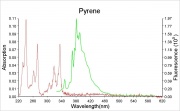Carbon tetrachloride
Jump to navigation
Jump to search
Description
A colorless, volatile liquid with a sweet, distinctive odor. Carbon tetrachloride was first produced in 1839 in Germany. It was used for many years to dissolve waxes, fats, and degrease metals. It was also a popular dry cleaning solvent and spot remover, however it is no longer widely used because of its toxicity. Carbon tetrachloride was once used as a single component fumigant and as a component in funigamt mixtures (Dowfume 75). Carbon tetrachloride was also used for a while in fire extinguishers (Pyrene), but was discontinued because it decomposed in high heat to form Phosgene, a highly poisonous gas.
Synonyms and Related Terms
tetrachloromethane; tetrachlormethane; perchloromethane; tetrachlorocarbon; Carbona; Pyrene
Risks
- Nonflammable.
- Forms phosgene in electrical fires, high heat or ultraviolet light.
- Very toxic by inhalation, ingestion and skin absorption.
- Carcinogen and teratogen in both males and females.
- ThermoFisher: SDS
Physical and Chemical Properties
- Miscible in ethanol, benzene, chloroform, ether, carbon disulfide, ligroin.
- Insoluble in water at room temperature. At elevated temperatures, carbon tetrachloride can slowly react with water to form hydrochloric acid.
| Composition | CCl4 |
|---|---|
| CAS | 56-23-5 |
| Melting Point | -23 C |
| Density | 1.589 g/ml |
| Molecular Weight | mol. wt. = 153.8 |
| Refractive Index | 1.4607 |
| Boiling Point | 76.7 C |
Comparisons
Resources and Citations
- R. J. Gettens, G.L. Stout, Painting Materials, A Short Encyclopaedia, Dover Publications, New York, 1966 Comment: sp. grav. = 1.629
- G.S.Brady, Materials Handbook, McGraw-Hill Book Co., New York, 1971 Comment: p. 147
- Reed Kay, The Painter's Guide To Studio Methods and Materials, Prentice-Hall, Inc., Englewood Cliffs, NJ, 1983
- Ralph Mayer, A Dictionary of Art Terms and Techniques, Harper and Row Publishers, New York, 1969 (also 1945 printing)
- Richard S. Lewis, Hawley's Condensed Chemical Dictionary, Van Nostrand Reinhold, New York, 10th ed., 1993
- Stephen R. Edwards, Bruce M. Bell, Mary Elizabeth King, Pest Control in Museums: a Status Report 1980, Association of Sytematics Collections, Washington DC, 1980
- Lynda A. Zycherman, J.Richard Schrock, A Guide to Museum Pest Control, FAIC and Association of Systematics Collections, Washington DC, 1988
- Michael McCann, Artist Beware, Watson-Guptill Publications, New York City, 1979
- Matt Roberts, Don Etherington, Bookbinding and the Conservation of Books: a Dictionary of Descriptive Terminology, U.S. Government Printing Office, Washington DC, 1982
- Van Nostrand's Scientific Encyclopedia, Douglas M. Considine (ed.), Van Nostrand Reinhold, New York, 1976
- Random House, Webster's Encyclopedic Unabridged Dictionary of the English Language, Grammercy Book, New York, 1997
- The Merck Index, Martha Windholz (ed.), Merck Research Labs, Rahway NJ, 10th edition, 1983 Comment: entry 1864
- The American Heritage Dictionary or Encarta, via Microsoft Bookshelf 98, Microsoft Corp., 1998
- Conservation termlist at www.hants.org.uk/museums (accessed 2001)
